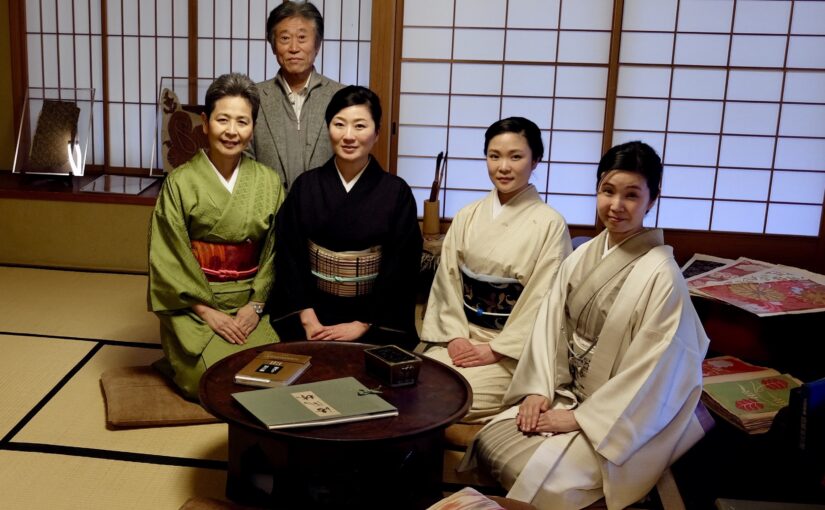I don’t buy new kimono off the shelf
As I wrote in my previous post, buying a kimono is quite different from buying a sweater off the shelf. Selecting the kimono and obi fabrics is only part of the process. There are more components to be added and complex processes involved.
The kimono fabric needs to be sewn. The correct measurement is critical, and depending on how the kimono is used, the measurement varies.
In my case, for example, I mainly want to wear the matcha-color kimono for tea ceremonies. In tea ceremonies, I often sit on my knees, stand up and sit down, and move around while kneeling down. The overlapping part of my kimono, therefore, needs to be kept wider than the usual size.
Depending on the season the kimono is worn, a lining fabric that matches the color and the material needs to be added.
Depending on the formality of the kimono, the crest design needs to be added. How large the crest design should be, whether it should be dyed or embroidered… More choices to make.
A set of kimono and obi needs more accessories, such as obiage and obijime. The color and the texture of those accessories are critical for giving a sophisticated finishing touch.
The process of making a kimono itself is a project. You need a project manager, like a general contractor, who oversees the whole process. Such a person shouId have a network of experts like sewing specialists and crest embroyders. The kimono retailer plays that role.
The kimono retailer’s job doesn’t end witht the completion of making a kimono.
Once the kimono is completed, you need someone to help take good care of it, including cleaning up, repairing, or resewing if needed. If you want another obi to match that kimono, you might want to tap into the kimono retailer’s knowledge of which type of obi is appropriate for which occasions.
So you want to build a long-term relationship with your kimono retailer.
It was Marusudi-san who introduced me to Katsuyama-san and Rakufulin. Once I selected the matcha-color kimono fabric, Marusugi-san took over the rest of the process. I assumed that my first kimono retailer would be Marusugi-san for some time.
I had to change course, however. Marusugi-san had decided to shift her business focus from kimono retail to sericulture in Laos! Now she and her company spend significant parts of each year in Laos growing silkworms and producing silk not for kimono fabric but for medical use.
How and why Marusugi-san made this huge shift itself deserves a separate blog post, and I admire their decision. As a result, I had to find another retailer for my kimono collection. I needed another reliable retailer who has an account with Rakufulin, and who was accessible.
At Rakufulin’s annual show, when I was about to leave, Reiko-san stopped me to introduce me to a person who just came in. “Akemi-san, this is Mamiya-san, one of our long-time retailers. Mamiya-san, this is Akemi-san, who lives in Seattle but is now back in Japan for a week.”
Mamiya-san was with his customer, whom I was intrigued by her kimono and obi coordination. She wore an off-white haori (jacket), a beige kimono, and an obi with a similar color base. Quite a harmonious, soothing tone. The kimono had vertical stripes with color gradations. It was not eye catching, but I liked the sophisticated look.
Mamiya-san has been doing business with Rakufulin since Shodai, Reiko-san’s grandfather’s days. He said he is delighted to see the Horie sisters (Reiko-san and Aiko-san) keeping on with the tradition and at the same time challenging conventions of this centuries-old industry.
Which part of traditions is it important to keep, I asked. Mamiya-san said, “handcrafting.” Machine-made fabrics are nice, but they don’t have the same soul. He told me about his daughter’s experience. She was an apprentice of a well-known potter in Kyoto and now has her own practice. The plates and cups that she makes may not be in perfect shape when compared with machine-made products, but they have warmth that no machine-made items would give you.
How are the Horie sisters challenging the industry convention, I asked. Mamiya-san said he was referring to Katsuyama-san’s way of making silk. More than ninety percent of silk used for kimono making is imported. Growing silkworms on their own itself is challenging convention.
Mamiya-san pointed out another challenge of the Horie sisters, which surprised me. The fact that Rakufulin now sells not only obi but also kimono fabrics. The convention of Nishijin has been that an obi maker sells only obi, and a kimono fabric maker sells only kimono fabric. When Rakufulin started selling Katsuyama-san’s kimono fabric, it was a big deal, almost a scandal.
I asked where Mamiya-san’s shop is located. Turned out it is very close to where my mother lives in Osaka. Great!
I didn’t tell Mamiya-san right away. I first had to talk to Marusugi-san. But in my mind it was already set. Mamiya-san will be my new retailer.
